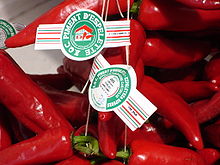Institut national de l'origine et de la qualité
The Institut national de l'origine et de la qualité (INAO) ( German : National Institute for Origin and Quality) is a state institution in France that oversees food produced in the mother country. It reports to the Ministry of Agriculture. For this purpose, standards have been developed that guarantee the consumer the origin and quality through appropriate labeling . Wine , cheese , meat and vegetables are included in this quality assurance .
history

A law of August 1, 1905 established quality standards for certain agricultural products. Another law of May 6, 1919 laid down penalties for non-compliance with these regulations. In the wine production in particular, offenses were repeatedly found, which then resulted in processes lasting for years. The initially loosely organized commission was combined by decree of July 30, 1935 to form the INAO, i.e. a state institute, in order to be able to control all administrative, judicial and financial tasks centrally. This date is now considered the foundation date of INAO. A year later, the first Appellation d'Origine Contrôlée (AOC) laws were enacted, which above all laid down the boundaries of the classified regions as well as the yield limits and which had been drawn up by the INAO. By the end of 1937, all of France's major wine-growing regions had their own AOC regulations.
In 1957, the Bresse chicken was the first animal to be placed under AOC protection.
Other tasks
In order to achieve an effective quality improvement, the INAO has also dealt with the optimal tasting of wines. For this purpose, the so-called INAO wine glasses were developed in the early 1970s , which, thanks to their special shape , should enable the most effective sensory tasting possible. These glasses were standardized in 1977 in a transparent and an opaque variant for blind tastings in the international standard ISO 3591, which was also valid in Germany from 1981 as DIN 10960. Since 2000, however, the German standard has specified a different glass shape, developed in Germany, with the same filling quantity, especially in the total volume and thus in the so-called headspace, a larger glass shape.
Numerous other events such as SISQA, Semaine Internationale Sécurité & Qualité Alimentaires round off the institute's public relations work.
Web links
Individual evidence
- ↑ ( Page no longer available , search in web archives: PDF )
- ↑ INAO ( Memento from April 12, 2013 in the web archive archive.today ). In: hch.de.
- ↑ Tasting glass. In: manufactum.de. Retrieved December 4, 2017 .
- ↑ Trial glasses ( Memento from May 6, 2014 in the Internet Archive ). In: wein-brenner.de.
- ↑ Standardized form : DIN wine test glass from Schott Zwiesel
- ↑ DIN test glasses ( Memento from April 12, 2013 in the web archive archive.today ). In: weinregal-profi.de.
- ↑ Communique de Presse ( Memento of January 11, 2016 in the Internet Archive ) In: inao.gouv.fr. (French, PDF; 189 kB).
